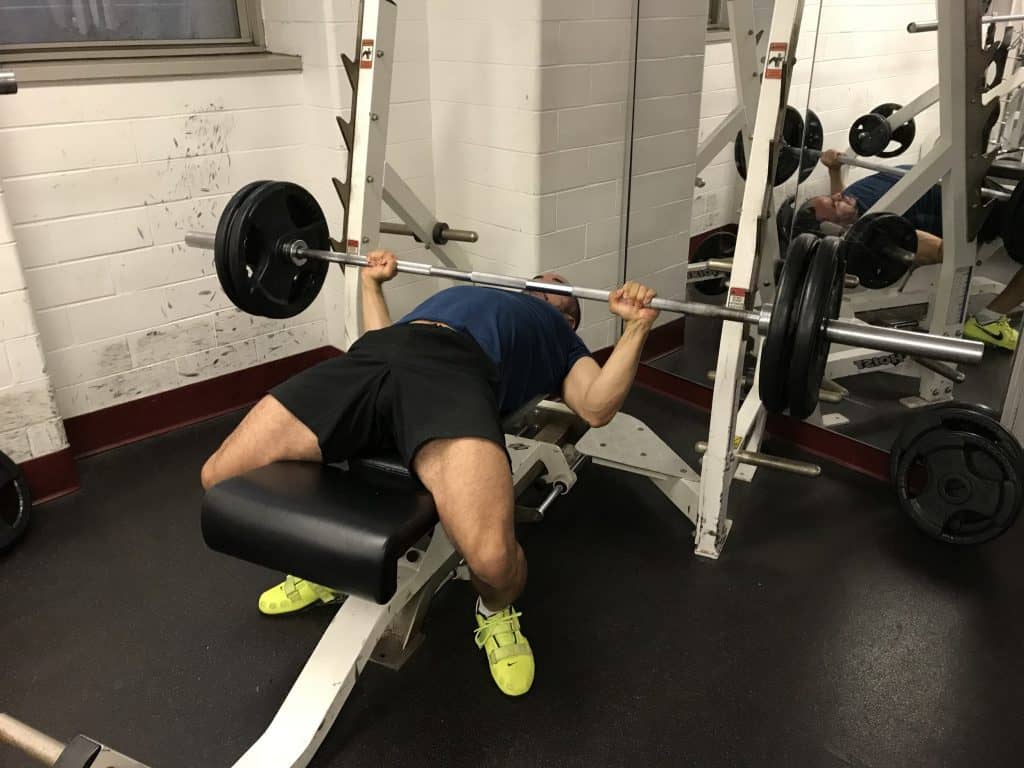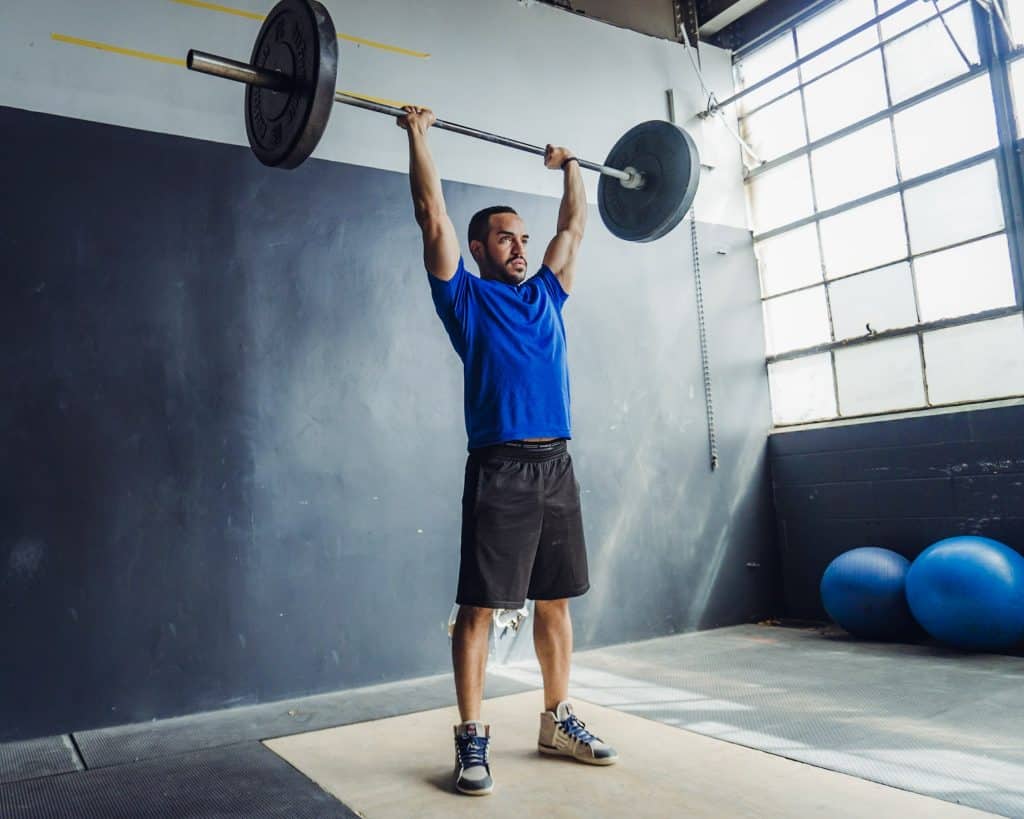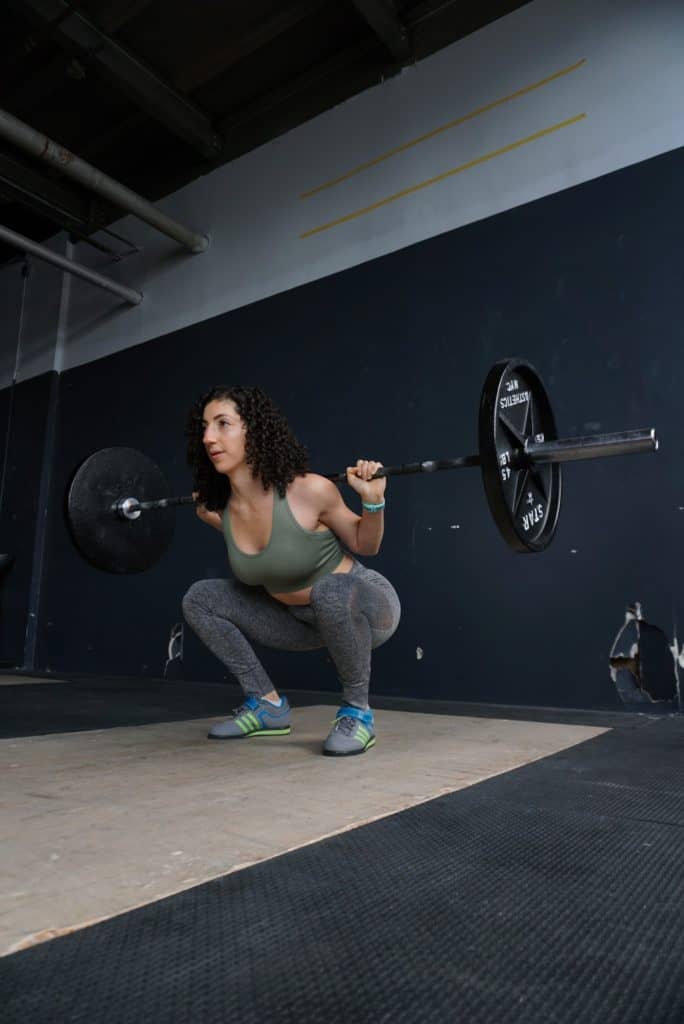How much weight should you lift?
Should you lift ‘light’ weights for high reps? Or should you lift heavy weight for lower reps?
After reading this post, you are going to learn:
- What is the ideal weight to build muscle,
- When to add weight to your exercises, and
- How to create a weight training program using the appropriate weight.
Let’s get started!

How Much Weight Should You Lift To See Results?
The amount of weight you should lift depends on what your primary fitness goal is.
- If your goal is to build strength, then your weights should be heavy enough that you can only perform 4-6 repetitions per set.
- If your goal is to build muscular size, then you should only be able to perform 7-12 repetitions per set.
- If your goal is to improve muscle endurance, then 12-15+ reps per set is best.
Let’s go over each goal in more detail.
How Much Weight Should You Lift To Gain Muscle?
If you want to gain muscle, then you need to lift a weight where you can only do 7-12 repetitions per set.
Notice that I am not recommending a specific weight.
That’s because this weight will be unique to you and your fitness level. You may only be able to lift 100 lbs for 7-12 repetitions, whereas someone else could do 200 lbs.

The actual weight doesn’t matter. It’s the stimulus your muscles receive from the workload that matters.
In addition, the weight you’re lifting should change on a regular basis. That’s why a range of 7-12 repetitions is prescribed.
You can’t expect to lift the same exact weight for the same number of repetitions over and over and see results.
You must progressively overload your muscles with new stimuli over time.
Is It Better To Lift Heavy or Light Weights To Build Muscle?
Ideally, you should use a combination of both heavy and light weights to build muscle.
Remember, “heavy” and “light” are always relative.
The less experience you have, the more you should focus on lifting in the 7-12 rep range, as you are learning proper technique.
Over time, you should add more weight to the exercises, slowly working your way down in repetitions.
For example:
You work in the 7-12 rep range for ~8-12 weeks. Then you increase the weight and train in the 4-6 rep range for ~4-8 weeks.
Improving your strength can also help you gain more muscle mass.
Once you have stronger muscles, you will notice that you can lift heavier weights in the 7-12 rep range compared to when you started.
You are setting a new baseline.
Do I Have To Lift Heavy To Build Muscle?
You do not have to lift really heavy to build muscle, but you should lift heavy enough to induce some level of muscular fatigue in every set.
I recommend sticking with weights heavy enough where you cannot accomplish more than 7-12 repetitions per set.
If you can easily get more than 12 reps per set, the weight is on the low side.
What About Strength?
If your primary goal is to build strength, then you need to lift heavy.
A heavier weight will train your nervous system to recruit more neurons to produce higher amounts of force.
I recommend picking a weight where you can’t lift more than 4-6 repetitions per set.
How Much Weight is Considered Heavy Lifting?
In general,
- anything above 200 lbs for upper body exercises is considered heavy, and
- anything above 300 lbs for lower body exercises can be considered heavy for most people.
To recap this section:
- Gaining muscle mass will require you to learn proper techniques in the major functional exercises.
- Begin by training in the 7-12 rep range for 2-3 months, and use progressive overloading to increase the weight over time.
- After 2-3 months of training, incorporate a strength training block, where you train in the 4-6 rep range for 1-2 months.
- Different weights will stimulate your nervous system differently, improving muscle mass and strength.
What Is a Good Weight To Start Lifting As a Beginner?
If you are a beginner, you should not start with the heaviest weight you can handle.
Instead, you should start with lighter weights and work your way up. In fact, the empty barbell is a good place to start!
A standard Olympic barbell weighs 45 lbs/20 kg.
If this is too heavy, then you can start off with a smaller barbell. Most gyms will have 15 lb barbells as well.
Is 45 lbs / 20kg enough to build muscle?
If you are an absolute beginner, 45 lbs will be enough to build muscle. With that said, it also depends on the specific exercise.
45 lbs might be too light for your lower body, but plenty for your upper body.
How Do I Know If I Am Using The Correct Weight?
Here are three things you can do to ensure that you are using the right weight:
- Make sure that you are in the appropriate rep range for your desired goal (4-6 for strength, 7-12 for muscle growth, and 12-15 for endurance)
- Do not exceed a Rate of Perceived Exertion (RPE) of 9
- Stop the set once your form begins to break
Let’s go over each one of these in more detail.
Work In Your Desired Rep Range
Do not make the mistake of going to either extreme.
Do not lift weights so light that you can easily exceed the goal rep range.
Similarly, do not lift weights so heavy that you cannot get the minimum number of reps dictated by the goal rep range.
Find the sweet spot right in the middle.
Do not exceed an RPE 9
What does RPE 9 mean?
Rate of Perceived Exertion or RPE is a method in which you grade how difficult a set is.
If it was a max effort set, and you could not get another repetition no matter what, it is a level 10.
If you were able to get one more repetition if you really needed to, (and only one), you give it a 9.
If you had two reps left in the tank, then the RPE would be 8, and so on.
Determining RPE can be very difficult at first, but get into the habit early of assigning every working set an RPE.
Never go lower than an RPE 7 on a working set.
Stop The Set If Your Form Breaks
If you are using RPE’s correctly, then ideally, your form shouldn’t break too much.
However, if you begin to notice that every subsequent rep you do looks drastically different from the first rep in the set, then stop.
Also, if your first set is starting to look substantially different from your current set- it’s time to stop.
The risk of injury is too high.
Use proper form!
Safety > Reps… Always.

When Should You Start Adding More Weight?
Here are the three most common scenarios in which you add weight:
- You are doing sets at an RPE of 7 or less
- You can do 12 reps or more on any given weight
- You have been doing the same exercises with the same weight for 3 weeks or more
If you are a beginner, you can increase the weight as often as every workout, or every week. As an intermediate you can increase the weight every 1-3 weeks.
How Should You Start Adding Weight?
It is always a good idea to add weight as slowly as possible.
This means adding no more than 5-10 lbs to the barbell at any time. Just because you can lift more weight doesn’t mean you should.
Take your time, add weight gradually, and focus on doing a little bit more on your next workout.
This is the entire basis behind progressive overload. Using this technique will allow your body and joints to accommodate to the external resistance over time.
Here are some examples.
- Week 1: Bench Press 135 lbs 3 x 8
- Week 2: 140 lbs 3 x 8
- Week 3: 145 lbs 3 x 8
- Week 4: 150 lbs 3 x 7
- Week 5: 155 lbs 3 x7
How Much Weight Should I Be Able To Lift For My Age or Size?
Most people should be able to do 25 pushups, 8 pullups, and hold a plank for at least 45 seconds.
Second of all, you should be able to lift a certain amount of weight on The Big 4– the squat, the bench press, the deadlift, and the overhead press.
These numbers are based on a one rep max, which is the maximum amount of weight you can handle for one repetition.
We have written an entire post on How Strong Should I Be? Realistic Strength Standards For Busy Professionals.
Check it out and let us know how you stack up, and where you need improvements.
Other Related Questions
How Much Weight Should I Lift With Dumbbells?
Just like with barbells, it is ideal to start as light as possible.
Start with just 10 – 20 lbs of dumbbell weight, until you have developed good technique in all of the basic movement patterns.
There are 6 fundamental exercises you should learn.
Again, it is always better to leave something in the tank than to go all out and potentially injure yourself.
Or You Can Also Just Lift Your Own Bodyweight
One last option is lifting your own body weight.
This is ideal if
- You do not have access to weights
- You want to workout at home, and do not want to commute to a gym
- You want to learn the basic fundamental movement patterns
Doing bodyweight exercises also has several unique advantages over weights.
We have an entire article going over how to decide if you should lift your body or lift weights, and an entirely separate article on how to begin training with your bodyweight from A to Z which you can find here- Calisthenics For Beginners.
What About Weight Loss? How Much Weight Should I Lift To Lose Weight?
If your goal is to lose weight, then you should still focus on lifting weights heavy enough for muscle gain, and weights heavy enough to build strength.
By increasing your lean muscle mass percentage, you will increase your body’s fat burning capabilities.
However…
You can exercise all you want, but you also need to address your nutrition. This is non-negotiable.
If you continue to eat a surplus of low-quality food, then you will never lose weight, no matter how much weight you choose to lift.
Exercise is only one small piece of the puzzle. Your diet is by far the largest piece.
Check out How To Lose Fat Without Losing Muscle to learn more.
How Much Weight Should I Lift To “Tone”?
There is a common misconception that in order to tone, you must lift “light weights” for high reps.
Believe it or not, there is no such thing as toning. You can either build muscle or lose fat. That is all.
High repetitions only serve to build aerobic and muscular endurance.
If you want to tone up, then you need to drop your body fat percentage while building muscle.

- The first step is to focus on building some muscle size
- The majority of your training should be done in the 7-12 range.
- At the same time, drop your body fat percentage by decreasing your calories and increasing your physical activity
- Lastly, keep your metabolism strong by keeping your body in motion. The easiest way is to walk, walk again, and then walk some more.
I go over more details in my post: The Truth About Toning: What You Need To Know.
How Much Weight Should A Woman Lift?
Another misconception in the fitness world is that women should lift light weights.
Women can and should incorporate heavy resistance training into their fitness regimen.
This is especially true for women who are entering menopause, as your risk of developing osteoporosis and suffering fractures increase.
Just like men, women should lift weights heavy enough to perform just 7-12 repetition per set when developing muscle, and 4-6 reps per set when developing strength.
Don’t be afraid of getting bulky.
Believe it or not, getting bulky is actually very difficult. It requires:
- a great deal of discipline,
- a dedicated training plan with the goal of getting bulky
- a calorie surplus
- years of hard work
- high levels of testosterone

In general, women don’t have high enough levels of testosterone to get bulky.
Any ‘bulky’ woman you meet probably trains for a living and is doing everything she can to get bulky.
Just take a look at Brittany. She can squat >200 lbs and deadlift >300 lbs and she is not bulky.
How Much Weight Should A 14 Year Old Lift?
As a young teenager, begin lifting as light a weight as possible to learn proper technique.
As you get comfortable with the foundational movement patterns, you should use weights where you achieve muscular fatigue in the 7-12 repetition range.
As you get stronger, the amount of weight you can lift in the 7-12 rep range will continue to increase.
Does lifting weights stunt your growth?
It’s a common misconception to think that lifting weights at an early age can stunt growth.
Studies have confirmed that a properly supervised training program using weights does not negatively impact growth in adolescents.
A Strength Workout Tells You How Much Weight To Lift and How To Increase It
That was a lot of information.
You can either digest all of this information and turn it into a comprehensive workout program for yourself…
Or you can let us put all the pieces together for you into one cohesive workout plan.
Enter The WCT Strength Program For Busy Individuals.
This easy to follow template takes all the guess work out and lays everything out for you.
Final Words How Much Weight You Should Be Lifting
So to wrap it all up:
- The amount of weight on the bar (or dumbbell) will always be inversely proportional to the number of repetitions you can perform on the exercise.
- The most important thing is to ensure that you are lifting with good form and changing up the rep scheme that you are using from time to time.
- If you are a beginner, stick to the higher rep sets first, and progressively overload each exercise as time goes on with more weight.
- Compound exercises respond best to all rep ranges (12-15+, 7-12, 4-6, and 1-3), and build great strength in the 4-6 rep range and less.
- Once you are comfortable with an exercise, always use weights heavy enough to perform the desired rep range with moderate difficulty.
Well, that’s all we have for you.
Next, you should learn:
- How Often Should I Workout: Determine Your Optimal Training Frequency
- The 3 Best Workout Splits Of All Time
- The Best Workout Template For Busy People
Now it’s your turn.
Have you been lifting appropriately heavy weights in your training?
Are your sets moderately difficult? Or are they pretty easy?
Comment below and let us know!

Alex Robles, MD, CPT / Brittany Robles, MD, MPH, CPT
Alex & Brittany Robles are physicians, NASM Certified Personal Trainers, and founders of The White Coat Trainer: a resource dedicated to improving the health and fitness of busy professionals using time-efficient strategies. Their advice has been featured in My Fitness Pal, Prevention, Livestrong, Reader’s Digest, Bustle, The Active Times, and more. Learn more about them here.

What supplements if perferd to gain the most mass as possible.. I’ve been doing 10-12 reps and dropping to 4-6 bi monthly seems to be doing well but its like my workout is too easy? Is there anyway to get an advanced plan or guide? I look forward to a reply.
Thanks joe. M
Hi Joe,Thanks for your comment. I would actually recommend that you not rely on supplements, and focus on consuming as many nutrient dense foods as possible. If you really want to use supplements, a simple protein powder with minimal ingredients will suffice.
It’s great that you are varying your rep ranges. The workouts shouldn’t feel too easy. They should be tough but manageable. This is likely due to the weights not being heavy enough in your workout. If you are comfortable with the desired exercises, then use weights that are heavy enough that you can only perform the desired 4-6 reps. The key is to progressively overload all of these exercises with time. I will definitely create an advanced plan as some point. In the mean time, check out The Best Workout Template Article that we have written.
Hope this helps.
I’m an advanced 62 year old lifter. Because of injuries, I cant train shoulders or legs but this has been the case for several years. I have stopped making progress and need advice on how often to train. Now I train chest and triceps on Monday, Thursday and biceps/back on Tuesday, Saturday. My rep ranges on chest is 7-12 and 12-17 on all other body parts. I do about 8-11 sets for each body part on every workout. Please help. I’m 6-1, 230.
Hi Jerry
Its tough to answer your questions without looking at all of the specifics of your training program. In general progress always boils down to progressive overload – i.e doing slightly more work for each exercise over time. That could be by adding one more repetition gradually, or adding 5 more lbs to the lift etc. It might help to change up the exercise variations that you are using and then apply the principles of progressive overload on a weekly basis